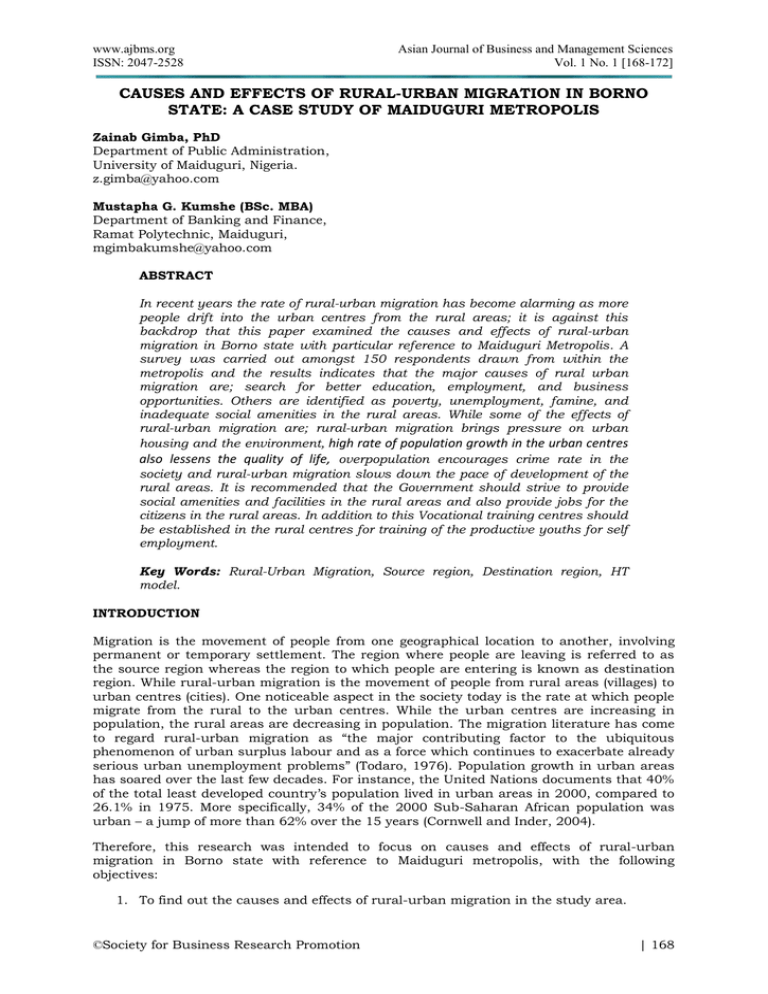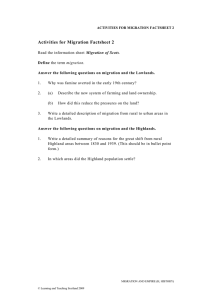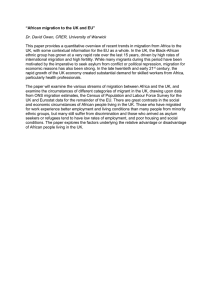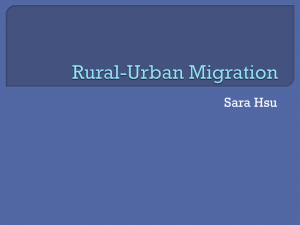CAUSES AND EFFECTS OF RURAL-URBAN MIGRATION IN BORNO
advertisement

www.ajbms.org ISSN: 2047-2528 Asian Journal of Business and Management Sciences Vol. 1 No. 1 [168-172] CAUSES AND EFFECTS OF RURAL-URBAN MIGRATION IN BORNO STATE: A CASE STUDY OF MAIDUGURI METROPOLIS Zainab Gimba, PhD Department of Public Administration, University of Maiduguri, Nigeria. z.gimba@yahoo.com Mustapha G. Kumshe (BSc. MBA) Department of Banking and Finance, Ramat Polytechnic, Maiduguri, mgimbakumshe@yahoo.com ABSTRACT In recent years the rate of rural-urban migration has become alarming as more people drift into the urban centres from the rural areas; it is against this backdrop that this paper examined the causes and effects of rural-urban migration in Borno state with particular reference to Maiduguri Metropolis. A survey was carried out amongst 150 respondents drawn from within the metropolis and the results indicates that the major causes of rural urban migration are; search for better education, employment, and business opportunities. Others are identified as poverty, unemployment, famine, and inadequate social amenities in the rural areas. While some of the effects of rural-urban migration are; rural-urban migration brings pressure on urban housing and the environment, high rate of population growth in the urban centres also lessens the quality of life, overpopulation encourages crime rate in the society and rural-urban migration slows down the pace of development of the rural areas. It is recommended that the Government should strive to provide social amenities and facilities in the rural areas and also provide jobs for the citizens in the rural areas. In addition to this Vocational training centres should be established in the rural centres for training of the productive youths for self employment. Key Words: Rural-Urban Migration, Source region, Destination region, HT model. INTRODUCTION Migration is the movement of people from one geographical location to another, involving permanent or temporary settlement. The region where people are leaving is referred to as the source region whereas the region to which people are entering is known as destination region. While rural-urban migration is the movement of people from rural areas (villages) to urban centres (cities). One noticeable aspect in the society today is the rate at which people migrate from the rural to the urban centres. While the urban centres are increasing in population, the rural areas are decreasing in population. The migration literature has come to regard rural-urban migration as “the major contributing factor to the ubiquitous phenomenon of urban surplus labour and as a force which continues to exacerbate already serious urban unemployment problems” (Todaro, 1976). Population growth in urban areas has soared over the last few decades. For instance, the United Nations documents that 40% of the total least developed country’s population lived in urban areas in 2000, compared to 26.1% in 1975. More specifically, 34% of the 2000 Sub-Saharan African population was urban – a jump of more than 62% over the 15 years (Cornwell and Inder, 2004). Therefore, this research was intended to focus on causes and effects of rural-urban migration in Borno state with reference to Maiduguri metropolis, with the following objectives: 1. To find out the causes and effects of rural-urban migration in the study area. ©Society for Business Research Promotion | 168 www.ajbms.org ISSN: 2047-2528 Asian Journal of Business and Management Sciences Vol. 1 No. 1 [168-172] 2. To examine the socio-economic status of the migrants. 3. To make suggestions where necessary. THEORETICAL FRAMEWORK According to Cornwell and Inder (2004) much of the contemporary literature on economic motivations for rural-urban migration builds on the seminal work of Todaro (1969) and Harris and Todaro (1970). Their models has provided a widely accepted theoretical framework that explained the relationship between rural-urban migration and urban unemployment in many LDCs. Assuming potential migrants respond to the urban employment probability and treating rural-urban migration primarily as an economic phenomenon, the Harris-Todaro model (HT) then demonstrates that, in certain parametric ranges, an increase in urban employment may actually result in higher levels of urban unemployment and even reduced national product (the Todaro Paradox). The paradox is due to the assumptions that in choosing between labour markets, risk-neutral agents consider expected wages; that the probability of obtaining urban employment is approximated by the ratio of urban jobs to the urban labour force; and that the urban wage rate is considerably and consistently higher than the rural wage rate. Under these assumptions, inter-labour market (rural-urban) equilibrium mandates urban unemployment. This unemployment ensures that the expected urban wage is equal to the rural wage (which is assumed constant throughout). The repercussion of this simple set of assumptions is that contrary to received wisdom, once the migration response is factored in, several policies aimed at reducing urban unemployment will raise urban unemployment rather than reduce it (Riadh, 1998). In the HT model migration is regarded as the adjustment mechanism by which workers allocate themselves between different labour markets, some of which are located in urban areas and some in rural areas, while attempting to maximize their expected incomes. The model led to many applied studies most of which confirmed that the relative wages and the perceived probability of finding a job were indeed important determinants of a decision to move. Also, the main conclusion of HT model has had considerable influence on policy formulation in LDC’s. From the empirical point of view, the HT model generates unemployment rates which are implausibly high. From the theoretical point of view, the model leaves its driving force, the disparity of urban and rural wages and the fixity of urban wage, unexplained. However, the model, with or without fixed wages, can be modified in a number of ways to introduce many interesting aspects (risk aversion, priority hiring, informal sector, travel costs) which probably will reduce the level of unemployment as predicted by the starting model. One of the predictions of HT model was that the proportional equilibrium size of the urban traditional sector will vary inversely with the rate of job creation. Arellano (1981) indicated that this prediction refers to the steady state and is warranted by a specific assumption about the elasticity of the migration rate. Fields (1975) has presented four extension of HT model using “a more generalized formulation of the job-search process”.The result of these extensions is a much lower predicted unemployment rate. Fields (1989) has further built a multi-sector labour model including on-the-job search with many others interesting labour market features. The innovative aspect of this model is the distinction between the ex ante allocation of the labour force among search strategies and the ex-post allocation of the labour among labour market outcomes. Three principal results are derived: more efficient on-the-job search lowers the equilibrium unemployment rate; in rational expectations equilibrium, the average rural and urban wages will not be equal; modern sector enlargement may leave labour market conditions in one of the sectors unchanged, even when wages and employment in that sector are fully flexible (Riadh, 1998). By introducing optimal search behaviour, à la Stigler, into a dual sector urban economy of the Todaro-type, Mohtadi (1989) derive the probability of urban-formal sector entry as a function of the rural-urban migrants’ optimal search intensity. One crucial finding is that a ©Society for Business Research Promotion | 169 www.ajbms.org ISSN: 2047-2528 Asian Journal of Business and Management Sciences Vol. 1 No. 1 [168-172] higher formal sector wage, not only induces the usual Todaro effect of reducing the chance of entry (by increasing migration and thus urban unemployment), but also an opposite “ incentive effect ” which increases this chance, by a more intensive search on the part of those able to afford additional search ( Riadh, 1998). Vishwanath (1991) has formulated a theoretical model where temporal dimensions to urban prospects as well as the urban wage dispersion are considered. In this model, a rural individual, who is taken to be the decision-making entity, has three options: stay at home (rural location) forever, engage in rural-based search for a city job, or move to the city and engage in urban-based search. In addition, once employed in the city he can expect to further engage in employee or on-the-job search. The various search strategies are characterized by their respective rates of information flow, viewed as a random processes, and search costs. The expected-income maximizing individual takes his optimal decision in an environment characterized by urban wage dispersion (Riadh, 1998). Amano (1983) shows that in his model, where migration is governed by the HT mechanism but the urban wage rate, unlike in the HT model, is endogenously determined, the dynamic system has a unique equilibrium (steady-state) which contains, depending upon the parameter values of the model, either full employment with equal wage rates between the two sectors (urban, rural), or urban unemployment with a wage differential. In addition, the equilibrium turns out to be either stable or unstable, again depending upon parameter values. Barlett (1983) uses a dynamic version of the Todaro (1969) migration mechanism and shows that in this model the steady-state growth equilibrium is characterized by a positive unemployment rate and is unstable. Day et al (1987) find that in the framework of the basic HT model instability is indeed a possibility and that regular or irregular, non periodic fluctuations can be propagated. Funatsu (1988) and Neary (1988) have shown that, when land is explicitly included as a third scarce factor (with capital and labour) in agriculture, the stability condition when land is ignored is no longer either necessary or sufficient for stability (Riadh, 1998). In many communities the migration of one member of a family is often a family decision and recent field studies strongly suggest that interdependencies between family members and the existence of ties with the place of origin are of great importance to reach a better understanding of the decision-making process generating migration and transfers in the context of socioeconomic development (Collier and Lal , 1984 ; Banerjee, 1981 ; Ulack, 1986 ; Stark, 1995). After migration, members of the family are supposed pooling and sharing their incomes as a form of insurance against uncertain flows from specific markets. Thus, if future earnings are uncertain and imperfectly but positively related in a geographically specific area, and taking into account the roles of risk aversion and imperfect capital and insurance markets, the migration decision of a member family regarded as an investment implies a riskreducing portfolio diversification of income sources (Stark and Katz, 1986; Stark, 1991). STUDY METHODOLOGY A case study design was adopted in this research where Maiduguri Metropolis was chosen as a case study. The data for this study were mainly collected in areas where most of the people have migrated from rural areas. A random sampling method was used to select the respondents. A total of 150 respondents were involved in the study. Primary data for the study were gathered by using structured questionnaires and interviews. Secondary data were obtained from existing literature. The statistical tool used for data analysis is simple percentage. RESULTS AND DISCUSSION Gender Distribution of Respondents Survey data revealed that 72% of the respondents are males while 28% were females. This shows that male migrants constitute the majority among the migrants in Maiduguri Metropolis. ©Society for Business Research Promotion | 170 www.ajbms.org ISSN: 2047-2528 Asian Journal of Business and Management Sciences Vol. 1 No. 1 [168-172] Age Distribution of Respondents Findings from the study showed that 44% of the respondents fell within the age group of 21-30 years, 33% are within the age group of 31-40 years while 23% are within the age bracket of 41 years and above. It can be deduced that 77% of the migrants are in their middle ages. Marital status of Respondents Data indicate that a large majority of migrants are single as survey results revealed that 33% were married, 53% were unmarried while 13% and 7% were divorced and widowed respectively. Education Status of Respondents Findings from the study also indicate that 18% of the respondents have been to primary school, 40% have attended secondary school. While 20% have attended tertiary institutions like universities and Polytechnics/colleges of education. About 22% of the respondents have also attended religious schools. This shows that most of the migrants are literates. Causes of Rural-Urban migration The major causes of rural-urban migration is identified as; search for better wages, education, political and social stability, better technologies, employment and business opportunities. Others are poverty, unemployment, crop failures and famine, inadequate social amenities and facilities in the rural areas such as pipe borne water, electricity, good roads, hospitals, schools, vocational centres. Effects of Rural-Urban Migration As more and more people arrive in the urban centre, there will be insufficient jobs for them and the unemployment rate will increase there will be more workers chasing too few jobs this will lead to straining the resources of the government. Rural-urban migration brings pressure on urban housing and the environment as migrants arrive from rural areas they live on the streets and makeshift sub-standard accommodation before establishing themselves. The high rate of population growth in the urban centres also lessens the quality of life because it: destroys resources, such as water and forests, needed for sustenance. Rural-urban migration leads to overpopulation of the urban centres thus encouraging and raising the rate of crime in the society. Rural-urban migration also slows down the pace of development of the rural areas. CONCLUSION The rate of rural-urban migration is alarming in recent years and its effects are not only felt by the destination regions alone but also felt by the source regions-as facilities in the destination regions are overstretched, the source regions are virtually deserted. Unless the government provides the basic necessities of life to the rural areas and provide the productive youth in the rural areas with employment opportunities people will continuously drift in to the urban centres from the rural areas in search for better life and employment. RECOMMENDATIONS The following suggestions were made based on the findings of this study: 1. In view of the effects of rural-urban migration the Government should strive to provide social amenities and facilities in the rural areas. 2. The Government should also provide jobs for the citizens in the rural areas. 3. Vocational training centres should be established in the rural centres for training of the productive youths for self employment. 4. Those youths that passed out of the Vocational training centres should be given micro-loans as a start-up capital. ©Society for Business Research Promotion | 171 www.ajbms.org ISSN: 2047-2528 Asian Journal of Business and Management Sciences Vol. 1 No. 1 [168-172] REFERENCES Amano, M. (1983): "On the Harris-Todaro Model with Intersectoral Migration of Labour," Economica : 311323. Arellano, J. P. (1981): "Do More Jobs in the Modern Sector Increase Urban Unemployment?” Journal of Development Economics, 8: 241-247. Banerjee, B. (1981): "Rural-Urban Migration and Family Ties: an Analysis of Family Considerations in Migration Behaviour in India", Oxford Bulletin of Economics and Statistics, November: 321-355. Barlett,W. (1983): "On the Dynamic Instability of Induced-Migration Unemployment in a Dual Economy," Journal of Development Economics, 13, pp.85-96. Collier, P. and D., Lal (1984): "Why Poor People get Rich Kenya: 1960-1979", World Development, vol. 12, N°10:1007-1018. Cornwell, K. and Inder, B. (2004) Migration and Unemployment in South Africa: When Motivation Surpasses the Theory. Australia; Monash University. Day, R. H., S. Dasgupta , S. K. Datta and J. B. Nugent (1987) "Instability in Rural Urban Migration," Economic Journal, 97 : 940-950. Fields, G. S. (1975): "Rural-Urban Migration, Urban Unemployment and Underemployment, and JobSearch Activity in LDCs," Journal of Development Economics, 2 (2): 165-187. Fields, G. S. (1989): "On-the-Job Search in a Labour Market Model: Ex ante Choices and Ex-post Outcomes," Journal of Development Economics, 30: 159-178. Funatsu, H. (1988): "A Note on the Stability of the Harris-Todaro Model with Capital Mobility," Economica, 55 (217): 119-121. Mohtadi, H. (1989): "Migration and Job Search in a Dualistic Economy: A Todaro-Stigler Synthesis", Economics Letters, 29: 373-378. Neary,J. P. (1988): "Stability of the Mobile Capital Harris-Todaro Model : Some Further Results," Economica, Vol. 48, pp. 123-127. Riadh B. J. (1998) Rural-Urban Migration: on the Harris-Todaro Model. Maître de Conférences à l’ université de Bretagne Sud C.E.I.E Stark, O. (1991): The Migration of Labor. Oxford and Cambridge, M.A.: Basil Blackwell. Todaro, M. P. (1969): "A Model of Labor Migration and Urban Unemployment in Less Developed Countries," American Economic Review, 69: 486-499. Todaro, M., P., (1976), Internal Migration in Developing Countries, International Labour Office, Geneva. Ulack, R. (1986): "Ties to Origin, Remittances and Mobility: Evidence from Rural and Urban Areas in the Philippine", The Journal of Developing Areas, 20, April: 339-356. Vishwanath, T. (1991): "Information Flow, Job Search and Migration", Journal of Development Economics, 36: 313-335. Web References www.associatedcontent.com-Retrieved 19/05/11 ©Society for Business Research Promotion | 172




